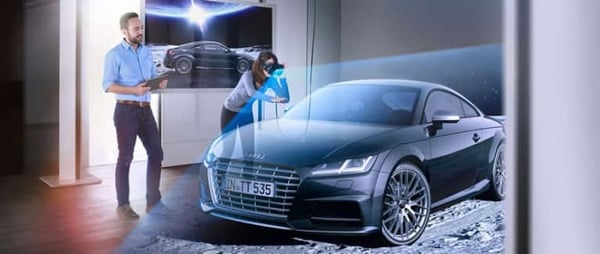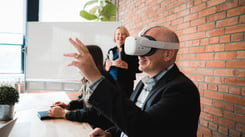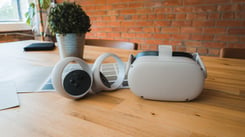Previously we’ve looked, in some detail, at the ways VR is being used by those in A&D to communicate complex designs. For clients, virtually experiencing space in 360° removes the need to visualize a multitude of disparate elements and subsequently leaves far less room for ambiguity around how a design will look when it’s brought to life. It’s a remarkable use case for VR but it shouldn’t be mistaken as the only clever tool in its business belt. In and beyond A&D, VR collaboration is being harnessed by businesses to ensure ideas are moving seamlessly across teams, no matter how far away they might be.
VR Collaboration is helping to change the way people work
For many organizations, internal teams aren’t only separated by a few walls but can, just as easily, be spread across cities, countries or even continents. True collaboration in separated environments can be a major challenge and also immensely inefficient as valuable ideas, discoveries and innovations that are made in one closed group, don’t make it to others which could benefit.
Big business - Big opportunity
International auto giant Volkswagen (which also owns Audi, Bentley, and Porsche among others) is no stranger to VR. The carmaker has previously created a host of applications that allow its customers to don headsets and virtually test out cars on famous racetracks, or spec out their ideal interiors direct from the showroom floor. Beyond rolling out experiences aimed at tantalizing customers, Volkswagen has recently brought virtual reality into the heart of its organization via the launch of its ‘Digital Reality Hub’. With over 600,000 employees working across multiple car brands and spread across 27 countries, the Company’s goal is to streamline its innovation by making remote team members working across brands, comfortable meeting with each other and exchanging knowledge.

In the words of Dennis Abmeier of Volkswagen Group IT, "Exchanging knowledge is just as important as bundling knowledge. Going forward, we can be virtual participants in workshops taking place at other sites or we can access virtual support from experts at another brand if we are working on an optimization. That will make our daily teamwork much easier and save a great deal of time.”
A problem shared (with VR) is a problem halved. Try a quick exercise. Envision telling someone what your kitchen looks like so they can help you remodel. Now consider - how much easier and faster is it if you show them a picture? Now, what if they could stand inside? Virtual reality collaboration brings a level of immersion that creates perfect understanding...no matter where your collaborators are located.

For designers, whether it be to get feedback on their work to explore possible improvements or to get help in solving design problems - collaborating with colleagues using VR allows for everyone involved to get visually up to speed in a very short time. Being immersed in a virtual environment delivers an immediate level of understanding that is almost impossible to achieve using traditional methods of design communication such as 2D renders or even shared CAD files. In a recent conversation with Diamond Schmitt Architects in Toronto, architect Andrew Chung told us the firm originally brought VR in to assist the team in collaboration. It was only later that they decided the experience was so good they should introduce it to their clients as well.
“Since we were working with multiple designs iterations in Revit, connecting everyone on the same level was extremely important. Throwing our design into VR would quickly reveal tasks and revisions we needed to accomplish and figure it out much more quickly in the design process. It gave us better opportunities to figure out solutions to the design problems earlier on. You would get more time to play creatively and explore solutions because fundamentally, you would get to the core of the design focus earlier as a result of this added understanding and resolution. Since the depth of exploration goes further, and our design gets better because we’re able to visualize problems earlier rather than waiting for problems to arise." We literally couldn’t have put it better ourselves.
Some Practical tips for VR collaboration for A&D
Make sure it’s mobile. ‘Fast VR’ means using the unique capabilities of VR in the most practical and efficient ways possible. When it comes to collaboration, making sure the VR tool being used is mobile friendly is key. Getting time-sensitive feedback from remote teams is far easier when everyone has a viewing device in the form of a smartphone in their pocket.
Make it social. VR can be isolating. We recognize that it’s a tool to help your colleagues understand the problem, but it’s your colleagues’ ideas that you need. When being asked to provide some insight or validation into a design, colleagues will commonly need only to pop in and out of an experience for short periods meaning strapping into cumbersome tethered rigs is impractical. Hold up the viewer, consider mirroring what the user sees on a conference room monitor - and put it back down to discuss the issue.
Perfection can wait. When working through the iteration stages of a design, for feasibility checks, etc, designs don’t need to be high quality to view in VR. Simple grayscale designs can be perfectly adequate to ‘pop into’ and determine if spatial elements work when put together or sightlines have been improved after an adjustment.
For some more information on VR, get in touch with us to schedule a training webinar for a full walkthrough of Yulio here. And, if you’re ready to test out the problem-solving capabilities of VR, sign up for a free Yulio account.



.jpg?width=245&height=150&name=active-adult-beautiful-1799244%20(1).jpg)


